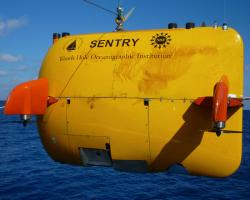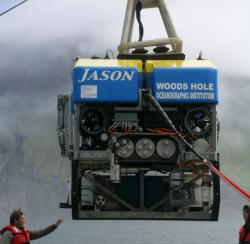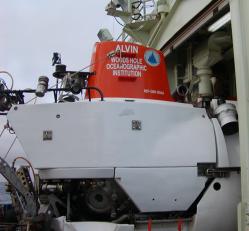December 9, 2010Source: Media RelationsThe U.S. National Deep Submergence Facility (NDSF) has had a growing and important role in the ocean science community’s response to the 2010 Deepwater Horizon oil spill in the Gulf of Mexico. With the recent R/V Atlantis/Alvin expedition (Nov. 8 – Dec. 3), now each of the NDSF vehicles – the autonomous underwater vehicles (AUV) Sentry, the remotely operated vehicle (ROV) Jason, and the manned submersible Alvin – has been employed in the Gulf, to characterize the plume, collect samples, and map and explore the seafloor for signs of the spill’s impact. “The Deepwater Horizon spill brought our attention to the deep seafloor as never before. The impact of this spill is not just at the surface and along the coasts, but also at depth,” said Chris German, the chief scientist for the NDSF, which is operated by Woods Hole Oceanographic Institution (WHOI). “The NDSF has been able to support scientists around the U.S. in their response to the spill and with their ongoing research in the Gulf of Mexico. These vehicles are national assets.” The NDSF is a body of the University-National Oceanographic Laboratory System (UNOLS), which schedules the vehicles and U.S. research vessels to maximize their use by U.S. researchers. With their proven track record for reliability, the NDSF vehicles are frequently scheduled as much as a year in advance, delaying their availability for deployment to the Gulf. So while the AUV Sentry was able to start work there before the end of June, Jason did not arrive until October and Alvin only began work there in November. Well before any of the NDSF vehicles could be put in place in the Gulf, however, NDSF director Andy Bowen was already advising federal agencies and oil-industry responders on the technologies available for working in the deep and the capabilities of the NDSF suite of vehicles. “From the early days of the crisis, the knowledge and capabilities embodied within NDSF offered both BP and the government useful insights into how to respond to this unprecedented disaster,” said Bowen.
Expeditions Using NDSF Vehicles in the Gulf In October, the ROV Jason was deployed by scientists aboard the NOAA vessel Ron Brown to examine deep-sea corals. Led by Chief Scientist Chuck Fisher of Pennsylvania State University, this cruise had been planned long before the DWH incident as part of an on-going four-year study, but the science team adapted their research plans so they could follow up on the oil spill. Their expedition used Jason to record video imagery of dead and dying corals located 11km (7 miles) SW of the Macondo 252 well, and to sample the affected coral communities to provide new information about the possible impact of the oil on coral communities. The cruise was funded by NOAA’s Office of Ocean Exploration and Research and the Bureau of Ocean Energy Management, Regulation and Enforcement (BOEMRE). In November, the human occupied submersible Alvin made its first foray into post-spill Gulf waters on a previously scheduled cruise to study brine pools in the Northern Gulf of Mexico. Led by Chief Scientist Samantha Joye of the University of Georgia, the expedition made additional dives in order to collect sediment and water columns samples in the vicinity (2.5 miles and further out) of the Deepwater Horizon wellhead. In early December, Alvin returned to the Gulf along with Sentry aboard RV Atlantis for a cruise funded through the NSF-RAPID program, augmented with a grant from the Census of Marine Life, to examine in greater detail the coral communities visited in October by Fisher’s team using Jason. Fisher led the return expedition, accompanied by many of the same researchers from the previous Jason expedition. They used Sentry and Alvin in tandem in a hunter-gatherer approach, with Sentry scouting the seafloor and creating maps to inform the science party’s decisions on where to return for a close-up look with Alvin “As most scientists will attest, there is no substitute for the direct observations one can make from a manned vehicle like Alvin,” said German. “Seeing the three-dimensional seafloor environment with human eyes is an enormous advantage when trying to make sense of complex interactions between deep-sea animals and their rock or sediment environments.” Originally published: December 9, 2010 Last updated: July 28, 2014 | |||||||||||
Copyright ©2007 Woods Hole Oceanographic Institution, All Rights Reserved, Privacy Policy. | |||||||||||




